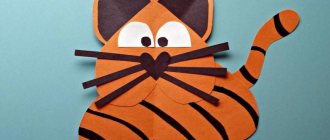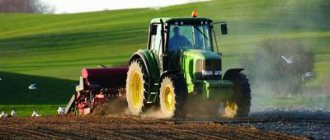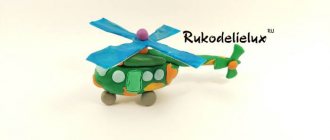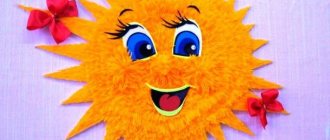Learning how to make a car out of plasticine will be interesting not only for boys, but also for girls. While working, children will be able to better understand how transport works and will be able to collect for themselves a collection of “real” cars or characters from their favorite cartoons. And even adults will enjoy assembling very realistic models and miniatures - it’s painstaking work, but the result is worth the effort, and besides, ready-made crafts can be used to decorate the interior or given to friends who are car enthusiasts.
- Step-by-step instructions with pictures on how to make a simple car from plasticine for children and beginners
- Video master classes on sculpting lightweight plasticine cars
- Plasticine crafts: cars
- A simple machine for little ones
- How to make a police car from plasticine
- Little racing car
- A simple car for the little ones
- Racing Nissan GT-R
- Fire truck made of plasticine: photo examples
- BMW passenger car and other model models
- Mercedes-Benz G-550
- BMW
- Nissan Silvia
- Complex realistic Alfa Romeo model
- Photo examples of other machines
- Miracle of the machine and Flash from plasticine
Lesson in the preparatory group on sculpting “Fire Truck” (plasticineography)
Marina Smirnova (Solovieva)
Lesson in the preparatory group on sculpting “Fire Truck” (plasticineography)
Lesson in the preparatory group on sculpting “ Fire Engine ” ( plasticineography )
MBDOU "D/s No. 2 combined type"
preparatory group No. 2
Solovyova Marina Alekseevna
Educational: Teach children to draw “ Fire Truck ”
, achieve an accurate representation of the form, its structure and parts.
Developmental: Continue to develop an interest in working with plasticine using the familiar technique - plasticineography , develop fine motor skills.
Educational: to cultivate accuracy when doing work, to activate children’s imagination, to instill in children respect for a profession such as a firefighter , a respectful attitude towards their hard work, and an awareness of the dangers of this profession.
Preliminary work: Looking at illustrations with different types of transport, guessing riddles, reading poems on the topic, finger gymnastics “ cars ”
Materials and equipment:
Demonstration: photo of a fire truck .
Handout: Cardboard for each child, plasticine modeling board .
Looking at an illustration on the topic “ Fire Safety ”
; reading fiction.
Progress of the lesson:
Playback :Guys, guess the riddle:
The red tongue is not used to dozing.
Once or twice he licked all the wood. (fire)
Playback : What words helped you solve the riddle? (Red, licked all the wood)
Playback : You and I know how fire arises and who fights it. Just like in a real battle, firefighters suffer heavy losses in the fight against fire and constantly live a tense life full of anxiety from the dangers. This is a highly qualified service with an alarm system, powerful fire engines , pumping units, and special heat-protective suits. These people need to bow deeply for their work. It is necessary to respect their profession and be grateful for the work of these people, for their willingness to risk their lives to save others from harm. Tell me, how do firefighters get to a fire ? ( Firemen ride in cars )
Playback : Great, but our firefighters’ cars have broken down and they can’t save people. What should they do now? (We need to make fire trucks )
Playback : Let's help them and make fire trucks . And cars using a technique already known to you and me - plasticineography . But first we will stretch our fingers so that we can get precise lines.
One two three four five. (They move the machine forward and backward over each finger, starting with the thumb.)
The race can begin. (Now the same thing, but starting with the ring finger.)
In a circle, in a circle, forward and backward, (Now - in a circle in one direction and the other.)
But my fingers are slowing down my car . (Roll the machine again over the fingers , which are slightly bent.)
Closed. (They clench their fist.)
The car is already in the garage.
And the headlights went out, they don’t shine anymore. (They look into the small crack in the fist.)
Playback : Well done! We will carry out our work in three stages. And for this we need a sheet of cardboard, a simple pencil and colored plasticine .
Stage 1. Using a simple pencil, we draw the silhouette of a fire truck .
Stage 2. Apply red plasticine
Stage 3. Done! Now we need to add elements so that our machine
She looked like a firefighter . Add a ladder, a sleeve and number 01.
The children do the work.
An exhibition of fire engines . Children look at them, listen to the opinions of their comrades without interrupting them, and share their impressions.
Summary of direct educational activities in artistic creativity (drawing) on the topic “Fire Engine” Summary of direct educational activities in artistic creativity (drawing) on the topic “Fire Engine” Purpose: To consolidate.
Abstract of OOD on design in the preparatory group “Time Machine”. Program content: consolidate children's knowledge about time, professions, transport, continue to develop the skill of independently composing. Sculpting lesson notes. Plasticineography “Summer Forest” Tatyana Tuktamysheva Lesson summary on lenka (plasticineography) “Summer Forest” Goals and objectives: * development of fine motor skills * development of imagination. Master class “Do-it-yourself fire truck” All children really like to play with cars, and even girls! Children are especially attracted to construction equipment and special equipment. transport. And also kids. GCD for drawing in the preparatory group “A fire truck is rushing to a fire” “A fire truck is rushing to a fire” Program content: learn to convey proportions between objects and partial occlusion in a plot drawing. "Sunflower". Summary of a lesson on modeling using the non-traditional technique “plasticineography” in the middle group b] Goals and objectives. Teach children to create an image of a sunflower based on an unfinished composition (silhouette of a sunflower). Keep learning. Modeling lesson in the senior group “Here it is, the fragrant bread” (plasticineography) The children chose the theme for modeling on their own. Among all baked goods, bread turned out to be the most important, the most delicious, the most necessary.
Step-by-step instructions with pictures on how to make a simple car from plasticine for children and beginners
Children in the middle group of kindergarten or a little older can handle sculpting a car.
Let’s sculpt a plasticine car with children step by step:
- Cut the block into two unequal parts and form the body.
- Make niches for the wheels with a stack.
- Roll four balls and decorate tires.
- Draw pictures on the rims and design the wheel arches.
- Glue bumpers, mirrors, glass, headlights, license plates and door handles.
- Draw a line of doors using a stack.
Video master classes on sculpting lightweight plasticine cars
Summary of the lesson on sculpting “Cars”
Ekaterina Duke
Summary of the lesson on sculpting “Cars”
Artistic and aesthetic development. Modeling "Cars"
Goal: creating a social development situation in the process of artistic and aesthetic activity
Tasks:
• Formation of skills in sculpting a car from rolled out balls
• Continue to teach children to sculpt an object consisting of several parts of the same shape, but of different sizes.
• Develop speech and attention.
• Cultivate a sense of compassion for others.
Materials: plasticine, soft toy Murzik the cat, napkins, napkins for modeling.
Progress of the lesson
There's a knock on the door. Guys, someone came to visit us, I’ll go and have a look. The cat Murzik comes in.
Say hello to the guys! What a beautiful cat, fluffy and soft.
Murzik, you are so scared, who scared you so much? Guys, when I was walking towards you, I saw something like that on the street, they were honking, driving fast, fast, beeping (honking, I was so scared, what was it?
Educator: Children, what do you think scared our cat so much?
Murzik, sit and listen, the children will tell you everything they know about cars.
There are toy cars on the table.
Educator: Children, what do you see on the table? These are cars, how many are there?
Educator: This is a passenger car, it has wheels, windows, a steering wheel.
What kind of car is this?
Educator: Do you know what this car is called?
This is a truck, it has a body, windows, and a steering wheel. The truck can carry,
various loads in its body. Ask one of the children to take the cubes and unload them.
Can we transport the cubes in a small car?
Murzik, now you know what cars are, what kinds of cars there are.
Guys, when Murzik goes home, how can he cross the road? Are there cars driving there?
While the music is playing, you drive like a car, only the music stops playing and you stop.
Murzik, now guys, they’ll show you how you can make small cars out of plasticine at home
Technological map for sculpting “Machines” in the senior group
Irina Getman
Technological map for sculpting “Machines” in the senior group
Educational field: Creativity.
Section: Modeling .
Topic: Cars .
Goal: the ability to convey the characteristic features of a car using plasticineography techniques .
— deepen and expand children’s knowledge about ground transport;
- learn to identify similar and different characteristics of cars and trucks - size , color, shape;
- learn to identify parts of cars - trunk , hood, body, wheels, steering wheel, etc.;
— develop the ability to paint over an image of a car with plasticine;
— continue to introduce children to the unconventional drawing technique “plasticineography”
— conversation about cars and trucks;
- examination of subject pictures “Cars”
;
— reading poems and riddles about cars;
— p/i “Sparrows and Cars”
— cars;
— illustrations depicting cars;
“ machine ” handout
- blank images of cars (for each child)
There's a knock on the door. Guys, someone came to visit us, I’ll go and have a look. Bunny comes in.
Say hello to the guys! What a beautiful bunny, fluffy and soft.
Bunny, what happened to you, who scared you so much?
Guys, when I was walking towards you, I saw something like that on the street, they were honking, running fast, fast, beeping (honking, I was so scared, what was it?
Educator: Children, what do you think scared our bunny so much?
Children: cars
Bunny, sit and listen, the children will tell you everything they know about cars .
There are toy cars .
Educator: Children, what do you see on the table? These are cars , how many are there?
Educator: This is a passenger car, it has wheels, windows, a steering wheel.
car is this ?
Educator: Do you know what this car is called ?
This is a truck , it has a body, windows, and a steering wheel. The truck can transport ,
various loads in your body (sand, bricks, furniture)
.
Can we transport cargo in a small car
Bunny, now you know what cars , what types of cars there are .
Guys, when the Bunny goes home, how can he cross the road? Are there cars driving ?
Let's play with our hands
And remember about transport (connect fingers with thumb)
Let's fly on an airplane
Clouds, how are you living? (Represents the wings of an airplane)
Rocking in a boat
And we smile at the waves (Palms in a boat shape)
, depict waves)
We accelerate the motorcycle,
We play races (Clench your fingers into a fist, relax)
With wind, sun and friends. (Hands in a tube - blowing like a breeze)
; hands up are the rays of the sun. Hands point to friends)
Call transport with us. (Press the pads of the fingers against each other on the corresponding hands)
Bunny, now the guys will show you how you can make small cars from plasticine .
But we will not only sculpt, but also decorate our cars . You say, but we don’t have paints.
How will we paint with plasticine?
Let's sit down at the tables and paint the cars in bright colors .
(The teacher hands out car )
Familiarity with the depicted subject. Selecting a machine .
Showing the sequence of actions and sculpting .
1. Apply blue plasticine to the drawing, carefully, without going beyond the outline.
2.Now we need to add elements: wheels – black, headlights – yellow. Children choose any colors themselves.
You guys are so great! It turned out very well! Our cars are painted .
Reproduce: how to sculpt a car;
They understand: what parts the car consists of;
Apply: the ability to paint over an image of a car with plasticine, using the unconventional technique “plasticineography”
.
Technological map “Letters from the Queen of Mathematics” Technological map of organized educational activities in the senior group Educational area: “Cognition”. Section: "FEMP". Letter subject.
Plasticine crafts: cars
Plasticine cars that will be interesting to assemble for both children and adults.
A simple machine for little ones
A simple machine made of plasticine for children 3-4 years old, which consists of a minimum of parts.
If you install wire wheel axles in light plasticine cars, you will get real toys that can be rolled around.
How to make a police car from plasticine
A simple step-by-step master class on sculpting a police car from air plasticine.
A craft made from ordinary material with more complex details.
Using the same principle, you can make other simple cars from plasticine with your own hands, changing their design and equipment.
Complex plasticine police car.
Little racing car
Models of racing cars made of plasticine for toddlers and older children.
A simple car for the little ones
How to make a light car:
- Form a cylinder of bright color and give it the shape of a body.
- Roll out a thick black plate and cut out two pairs of circles with bottle caps: a larger one and a smaller one.
- Make small holes in the center of the tires using a toothpick and install the wheels in place.
- Glue two white stripes of the same width along the edges of the body and place a black ball between them - the racer’s helmet.
- Add a face to the pilot and attach a number plate to the hood.
- Form a number from a thin sausage; if desired, you can apply additional tuning to the body using a toothpick.
The rear wheels of a racing car are driven, so they must be larger.
Racing Nissan GT-R
In order not to make a mistake with the size when creating a realistic model, it is worth trying to make an exact copy of an ordinary toy.
As a base for the craft, you can use a matchbox covered with plasticine; this will help save material and reduce the weight of the figurine.
Fire truck made of plasticine: photo examples
A simple option with large details that even a small child can repeat.
If it is difficult for your child to roll up a thin fire truck hose from plasticine, you can use a thick cord instead.
Cartoon fire truck.
A simpler option for younger children.
Plasticineography and sausage applique.
A craft made from mastic that can be repeated using regular plasticine.
To ensure that the surface of the parts is smooth, it is smoothed with fingers dipped in cold water.
BMW passenger car and other model models
Simple car crafts made from plasticine for children, as well as very realistic models for older children or adults. Ready-made cars will be useful for games, collections, or as a gift to a friend or dad.
Passenger vehicles can be sculpted not only from ordinary plasticine, but also from sculptural plasticine, and finished models can be painted with gouache.
Mercedes-Benz G-550
A realistic model that will be interesting to replicate even for adults.
How to make a car from plasticine:
- Form a body from two blocks placed on top of each other.
- Use a stack or the back of the handle to make recesses for the tires.
- Install wheels.
- Add wheel arches and form the hood.
- Glue the bumpers and decorate the wheels.
- Add headlights, grille, number and logo.
- Design brake lights and muffler.
- Glue the glass.
- Carefully draw all the important elements in a stack.
BMW
Miniature collectible BMW model.
How to make a craft:
- Form the basic shape of the body and glue the wheels.
- Install the bumpers and use a stack to work out the body parts.
- Add colored elements.
- Draw the lines of the body and the pattern on the rims.
A very small BMW figurine. To prevent the craft from becoming dusty and losing its shape, it can be coated with varnish.
It’s better to start sculpting small plasticine cars with simple-shaped models - it’s easier to guess the proportions.
Nissan Silvia
Even a child from the senior group of kindergarten can handle such a plasticine figurine if adults help him.
To make a plasticine car, just follow the step-by-step photos, paying special attention to the accuracy of the lines and proportions.
Small plasticine cars do not take up much space, so you can collect a large collection of different models.
Nissan Skyline
Complex realistic Alfa Romeo model
In order for the car to turn out to be an exact copy of the real one, it is necessary to carefully reproduce all the details, checking the photo of the real car. Body stickers can be printed and cut out, or you can use ready-made ones from a regular toy.











